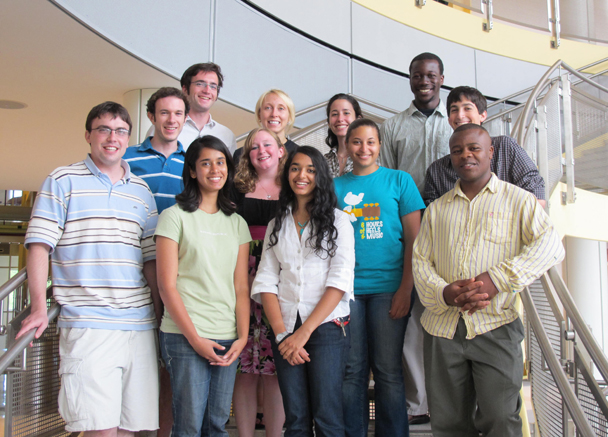| |
|
|
|
|
| |
|
|
|
|
| |
|
|
|
|
| |
|
MERIT
Fair 2011 |
|
|
| |
|
Overview, Project Abstracts, Presentation Slides & Posters, & Research Papers |
|
|
| |
|
Friday, August 5, 2011 |
|
|
| |
|
|
|
|
| |
|
|
|
|
| |
|
Some of the MERIT Fair 2011 Participants
(click on photos to enlarge)
|
|
|
| |
|
The MERIT Fair is held
at the end of the summer to showcase the research conducted by the
undergraduate students during the summer. This forum provides the BIEN students
with the opportunity to present their work to the wider public.
Their efforts are subjected to scrutiny from a panel of judges selected
from academia, industry, and government laboratories. Prizes were awarded for best
overall project, runner-up for best project, best technical report, and best presentation. |
|
|
| |
|
|
|
|
| |
|
MERIT
Fair 2011 Prize-Winning Projects |
|
|
| |
|
|
|
|
| |
|
|
|
|
| |
|
Biosystems Internships for Engineers (BIEN) |
|
|
| |
|
|
|
|
| |
|
|
|
|
| |
|
BIEN Project Abstracts, Technical Reports, and Presentation Slides |
|
|
| |
|
|
|
|
|
|
Micro-Robot Control and Coordination
Susana Galicia Llantin (University of Puerto Rico at Mayaguez)
Franklin Nouketcha (University of Maryland at College Park)
Mentors:
Prof. Pam Abshire (UMCP) and
Michael Kuhlman (UMCP)
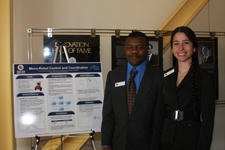 Miniature, self-sufficient robotic swarms have a wide range of applications, including infrastructure monitoring and rescue mission assistance. The main goal of this project is to make a decentralized group of mini-robots perform formation following using distance sensing only. Currently, the robots cannot directly measure wheel velocity or perform position tracking due to size and power constraints. However, analyzing calibration data will enable better control and estimation of the robot’s position over time using odometry. Furthermore, our control strategy requires a more precise distance sensor. We will refine sensor resolution through signal envelope interpolation. Solving these issues will result in an improved environmental awareness and optimal decision-making concerning motion control. Miniature, self-sufficient robotic swarms have a wide range of applications, including infrastructure monitoring and rescue mission assistance. The main goal of this project is to make a decentralized group of mini-robots perform formation following using distance sensing only. Currently, the robots cannot directly measure wheel velocity or perform position tracking due to size and power constraints. However, analyzing calibration data will enable better control and estimation of the robot’s position over time using odometry. Furthermore, our control strategy requires a more precise distance sensor. We will refine sensor resolution through signal envelope interpolation. Solving these issues will result in an improved environmental awareness and optimal decision-making concerning motion control.
Presentation Slides
Project Poster
Technical Report
|
|
|
|
|
Nose on a Chip
Hetal Patel (George Washington University)
Daniel Silversmith (University of Maryland at College Park)
Mentors: Prof. Pam Abshire (UMCP) and Timir Datta-Chaudhuri (UMCP)
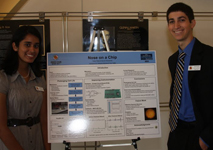 We aim to create a prototype olfactory sensor (“nose on a chip”) by interfacing olfactory sensory neurons (OSNs) with a microelectrode array (MEA) and observing extracellular electrical impulses in response to various odorants. Thus far, successful measurements have been recorded using bovine aortic smooth muscle cells (BAOSMCs) exhibiting spontaneous activity and in response to chemical stimuli. Specific challenges in using OSNs include prolonging cell life and improving the instrumentation used to measure action potentials. We have found that a membrane composed of either paraffin oil or polydimethylsiloxane (PDMS) successfully prevents dehydration while maintaining the viability of BAOSMCs for the duration of an experiment. A four-layer printed circuit board utilizes a 52-channel microelectrode array with 52 instrumentation amplifiers and can be integrated directly with common data acquisition software. Future developments include establishing methods to interpret and analyze the electrical responses in order to classify odor signatures. We aim to create a prototype olfactory sensor (“nose on a chip”) by interfacing olfactory sensory neurons (OSNs) with a microelectrode array (MEA) and observing extracellular electrical impulses in response to various odorants. Thus far, successful measurements have been recorded using bovine aortic smooth muscle cells (BAOSMCs) exhibiting spontaneous activity and in response to chemical stimuli. Specific challenges in using OSNs include prolonging cell life and improving the instrumentation used to measure action potentials. We have found that a membrane composed of either paraffin oil or polydimethylsiloxane (PDMS) successfully prevents dehydration while maintaining the viability of BAOSMCs for the duration of an experiment. A four-layer printed circuit board utilizes a 52-channel microelectrode array with 52 instrumentation amplifiers and can be integrated directly with common data acquisition software. Future developments include establishing methods to interpret and analyze the electrical responses in order to classify odor signatures.
Presentation Slides
Project Poster
Technical Report
|
|
|
|
|
Measuring Dielectric Properties of Simulants of Biological Tissue
Margaret Raabe (College of Wooster)
Mentors:
Prof. Christopher Davis (UMCP)
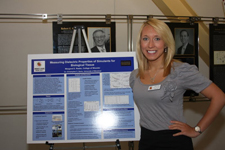 We strive to measure the dielectric properties of biological simulants, specifically the value of the dielectric constant for various liquids, and examine their dependency on frequency in the range 10 MHz to 100MHz. This value is determined by using an “open-coax” technique, in which an air-filled, open-ended coaxial line is immersed in the material of which the dielectric constant is desired. By using the known depth of the liquid partially filling the coaxial line and the dimensions of the inner and outer conductors, the dielectric constant can be determined. The calculations involve modeling the impedance of a liquid-filled coax line. Reliable values of dielectric constants of biological simulant materials are important to determine in order to support theoretical analysis and complex numerical modeling of the energy absorbed from wireless devices that are placed close to, or worn on, the human body. We strive to measure the dielectric properties of biological simulants, specifically the value of the dielectric constant for various liquids, and examine their dependency on frequency in the range 10 MHz to 100MHz. This value is determined by using an “open-coax” technique, in which an air-filled, open-ended coaxial line is immersed in the material of which the dielectric constant is desired. By using the known depth of the liquid partially filling the coaxial line and the dimensions of the inner and outer conductors, the dielectric constant can be determined. The calculations involve modeling the impedance of a liquid-filled coax line. Reliable values of dielectric constants of biological simulant materials are important to determine in order to support theoretical analysis and complex numerical modeling of the energy absorbed from wireless devices that are placed close to, or worn on, the human body.
Presentation Slides
Project Poster
Technical Report
|
|
|
|
|
Automatic Volume Leveler for Real Time Speech Applications
Justin Bare (University of Maryland at College Park)
Mentors:
Prof. Carol Espy-Wilson (UMCP) and
Dr. Tarun Pruthi (UMCP)
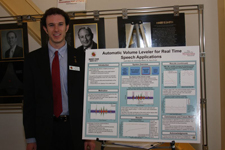 The goal of speech enhancement is to reduce the level of noise present in the signal while preserving the quality and loudness of the speech signal. However, speech enhancement often leads to amplification or attenuation of parts of the enhanced signal across time and possibly across frequency as compared to the original signal. As a result, the loudness and timbre (or color) of the speech signal may be changed. Corrective processing is complicated because there is no ground truth signal that can serve as a reference, and in any real time algorithm, the amount of look-ahead is limited. Therefore, any trivial signal normalization technique is useless. In this project, we intend to develop an automatic volume leveler to handle this problem of attenuation/amplification and restore the signal loudness and tilt to a level close to the produced speech signal while also ensuring that clipping does not occur. The goal of speech enhancement is to reduce the level of noise present in the signal while preserving the quality and loudness of the speech signal. However, speech enhancement often leads to amplification or attenuation of parts of the enhanced signal across time and possibly across frequency as compared to the original signal. As a result, the loudness and timbre (or color) of the speech signal may be changed. Corrective processing is complicated because there is no ground truth signal that can serve as a reference, and in any real time algorithm, the amount of look-ahead is limited. Therefore, any trivial signal normalization technique is useless. In this project, we intend to develop an automatic volume leveler to handle this problem of attenuation/amplification and restore the signal loudness and tilt to a level close to the produced speech signal while also ensuring that clipping does not occur.
Presentation Slides
Project Poster
Technical Report
|
|
|
|
|
Delta-Spectral Cepstral Coefficients for Robust Speaker Recognition
Jonathan Deutsche (Loyola Marymount University)
Mentors:
Prof. Carol Espy-Wilson (UMCP) and
Dr. Xinhui Zhou (UMCP)
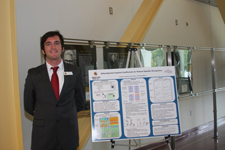 Most current speaker recognition systems use mel-frequency cepstral coefficients (MFCCs) in conjunction with delta-cepstral coefficients (DCCs) as their front ends. However, the speech signal can be altered significantly by channel effects, everyday background noise, and reverberation due to room acoustics. Such changes can greatly reduce the accuracy of speaker recognition systems. For this reason, it is desirable to develop a more robust front end processing system. Recently, it was shown that the accuracy of speech recognition systems can be improved by taking delta features in the spectral domain instead of in the cepstral domain. These delta-spectral cepstral coefficients (DSCCs), when used in conjunction with the MFCCs have been shown to be more robust to additive noise and reverberation than the MFCCs plus DCCs. In this project, the robustness of the MFCCs plus DSCCs will be tested in a text-independent speaker recognition system according to the NIST speaker recognition evaluation core-task. Most current speaker recognition systems use mel-frequency cepstral coefficients (MFCCs) in conjunction with delta-cepstral coefficients (DCCs) as their front ends. However, the speech signal can be altered significantly by channel effects, everyday background noise, and reverberation due to room acoustics. Such changes can greatly reduce the accuracy of speaker recognition systems. For this reason, it is desirable to develop a more robust front end processing system. Recently, it was shown that the accuracy of speech recognition systems can be improved by taking delta features in the spectral domain instead of in the cepstral domain. These delta-spectral cepstral coefficients (DSCCs), when used in conjunction with the MFCCs have been shown to be more robust to additive noise and reverberation than the MFCCs plus DCCs. In this project, the robustness of the MFCCs plus DSCCs will be tested in a text-independent speaker recognition system according to the NIST speaker recognition evaluation core-task.
Presentation Slides
Project Poster
Technical Report
|
|
|
|
|
Voice Activity Detection
Jonathan Kola (Harvard University)
Mentors:
Prof. Carol Espy-Wilson (UMCP) and
Dr. Tarun Pruthi (UMCP)
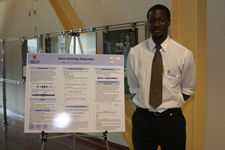 Voice activity detectors (VADs) are ubiquitous in speech processing applications such as speech enhancement, signal-to-noise ratio (SNR) estimation, speech recognition, etc. VADs attempt to distinguish between speech and non-speech regions in a signal. Current VADs use measures such as energy differences, periodicity, and spectral differences that exist between different sounds. Some models use heuristic algorithms, while others use statistical models in a supervised/unsupervised learning framework. In this project, I will compare different VADs described in the literature and evaluate them on a comprehensive set of noises and SNRs. Based on their performance, I will develop an algorithm that performs most accurately and consistently and produce and implementation in C. Voice activity detectors (VADs) are ubiquitous in speech processing applications such as speech enhancement, signal-to-noise ratio (SNR) estimation, speech recognition, etc. VADs attempt to distinguish between speech and non-speech regions in a signal. Current VADs use measures such as energy differences, periodicity, and spectral differences that exist between different sounds. Some models use heuristic algorithms, while others use statistical models in a supervised/unsupervised learning framework. In this project, I will compare different VADs described in the literature and evaluate them on a comprehensive set of noises and SNRs. Based on their performance, I will develop an algorithm that performs most accurately and consistently and produce and implementation in C.
Presentation Slides
Project Poster
Technical Report
|
|
|
|
|
What Is the Neural Basis of Rhythm?
Brendan Fennessy (University of Maryland at College Park)
Mentors:
Dr. Jonathan Fritz (UMCP) and Dr Stephen David (UMCP)
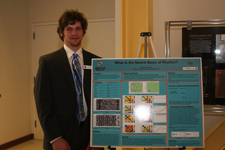 Experimental animals will be trained, using a conditioned avoidance paradigm, on variants of a rhythm discrimination task, whereby they must identify a target click train with a distinct rhythmic pattern in a sequence of reference click trains with a different pattern. The click trains will be interleaved with naturalistic, modulated bandpass noise that will allow for system identification analysis of neural temporal response properties. Through a comparison of neural responses during behavior and passive listening to these acoustic stimuli, the study aims to gain better insight into the neural basis and perception of rhythm and also will explore how neural representations in auditory cortex adaptively change to permit the discrimination of distinct rhythmic patterns. Experimental animals will be trained, using a conditioned avoidance paradigm, on variants of a rhythm discrimination task, whereby they must identify a target click train with a distinct rhythmic pattern in a sequence of reference click trains with a different pattern. The click trains will be interleaved with naturalistic, modulated bandpass noise that will allow for system identification analysis of neural temporal response properties. Through a comparison of neural responses during behavior and passive listening to these acoustic stimuli, the study aims to gain better insight into the neural basis and perception of rhythm and also will explore how neural representations in auditory cortex adaptively change to permit the discrimination of distinct rhythmic patterns.
Presentation Slides
Project Poster
Technical Report
|
|
|
|
|
Object Tracking and Selective Attention in a Bat-Inspired Echolocation System
Stephanie Doctor (University of North Carolina at Chapel Hill)
Sairina Mirchandani (Rensselaer Polytechnic Institute)
Mentors: Prof. Timothy Horiuchi (UMCP), Prof. Cynthia Moss (UMCP), and Tarek Massoud (UMCP)
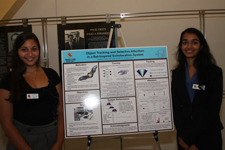 Air-coupled sonar is an important sensory system for navigation and feeding in echo-locating bats and potentially in man-made flying agents operating in complete darkness. This project will illustrate how echo-localization can be performed with a sonar system by implementing a learning approach in a neurally-inspired classifier network exposed to training data. Using this system mounted on a rotational joint, we will further demonstrate how it can be used to track objects and selectively attend to task-dependent salient points. Air-coupled sonar is an important sensory system for navigation and feeding in echo-locating bats and potentially in man-made flying agents operating in complete darkness. This project will illustrate how echo-localization can be performed with a sonar system by implementing a learning approach in a neurally-inspired classifier network exposed to training data. Using this system mounted on a rotational joint, we will further demonstrate how it can be used to track objects and selectively attend to task-dependent salient points.
Presentation Slides
Project Poster
Technical Report
|
|
|
|
|
Synthetic Flocking and Bioinspiration
Benjamin Flom (University of Maryland at College Park)
Mentors: Prof. P.S. Krishnaprasad (UMCP), Biswadip Dey (UMCP), and Kevin Galloway (UMCP)
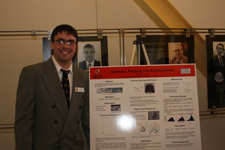 There has been a growing interest in understanding collective behavior in nature, in particular, how local interactions between animals give rise to seemingly coordinated behavior for an entire group. We studied position data collected every 20 milliseconds from a flock of ten trained pigeons, fitted with GPS-loggers (Nagy et. al., Nature, 2010). We hypothesized that the flock motion can be modeled as a problem of networked interaction with pigeons engaged in a particular pursuit strategy with respect to others in the flock. We tested this hypothesis and found evidence suggesting that some pigeons implement a constant bearing pursuit strategy. There has been a growing interest in understanding collective behavior in nature, in particular, how local interactions between animals give rise to seemingly coordinated behavior for an entire group. We studied position data collected every 20 milliseconds from a flock of ten trained pigeons, fitted with GPS-loggers (Nagy et. al., Nature, 2010). We hypothesized that the flock motion can be modeled as a problem of networked interaction with pigeons engaged in a particular pursuit strategy with respect to others in the flock. We tested this hypothesis and found evidence suggesting that some pigeons implement a constant bearing pursuit strategy.
Presentation Slides
Project Poster
Technical Report
|
|
|
|
|
Securing Biometrics Data: A Comparative Study
Melonie Hardy (Shorter University)
Brigitte Liu (City College of New York)
Mentors: Prof. Min Wu (UMCP) and Wenjun Lu (UMCP)
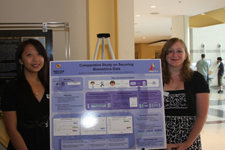 In an effort to make use of a swarm of ant-sized robots that lack optical sensing and advanced computation capabilities, we have developed a hybrid algorithm that implements image processing at high frame rates to develop fast and slow background adaptation techniques for real time external visual tracking of micro-robots using a single camera. The algorithm identifies each micro-robot, determines their position and orientation and computes their velocities. Ultimately, this information will be utilized in the control and coordination of these ant-sized robots by either transmitting it to individual micro-robots on request, or by using these parameters as inputs in control algorithms developed for the autonomous ant-sized robots currently under development at UMD. In an effort to make use of a swarm of ant-sized robots that lack optical sensing and advanced computation capabilities, we have developed a hybrid algorithm that implements image processing at high frame rates to develop fast and slow background adaptation techniques for real time external visual tracking of micro-robots using a single camera. The algorithm identifies each micro-robot, determines their position and orientation and computes their velocities. Ultimately, this information will be utilized in the control and coordination of these ant-sized robots by either transmitting it to individual micro-robots on request, or by using these parameters as inputs in control algorithms developed for the autonomous ant-sized robots currently under development at UMD.
Presentation Slides
Project Poster
Technical Report |
|
|
| |
|
|
|
|
| |
|
|
|
|

 In an effort to make use of a swarm of ant-sized robots that lack optical sensing and advanced computation capabilities, we have developed a hybrid algorithm that implements image processing at high frame rates to develop fast and slow background adaptation techniques for real time external visual tracking of micro-robots using a single camera. The algorithm identifies each micro-robot, determines their position and orientation and computes their velocities. Ultimately, this information will be utilized in the control and coordination of these ant-sized robots by either transmitting it to individual micro-robots on request, or by using these parameters as inputs in control algorithms developed for the autonomous ant-sized robots currently under development at UMD.
In an effort to make use of a swarm of ant-sized robots that lack optical sensing and advanced computation capabilities, we have developed a hybrid algorithm that implements image processing at high frame rates to develop fast and slow background adaptation techniques for real time external visual tracking of micro-robots using a single camera. The algorithm identifies each micro-robot, determines their position and orientation and computes their velocities. Ultimately, this information will be utilized in the control and coordination of these ant-sized robots by either transmitting it to individual micro-robots on request, or by using these parameters as inputs in control algorithms developed for the autonomous ant-sized robots currently under development at UMD.